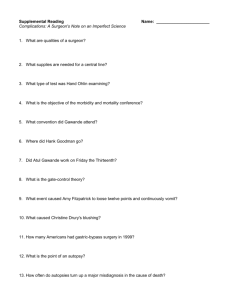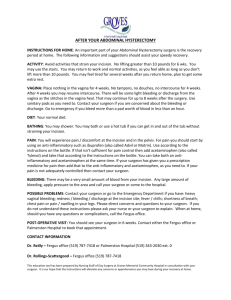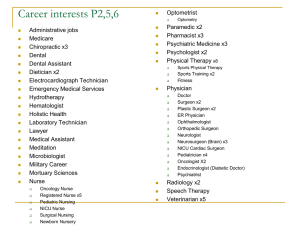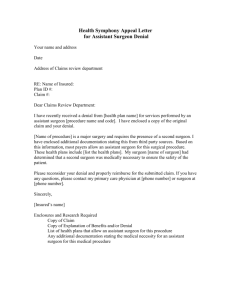RESPIRATORY DISSECTION
advertisement
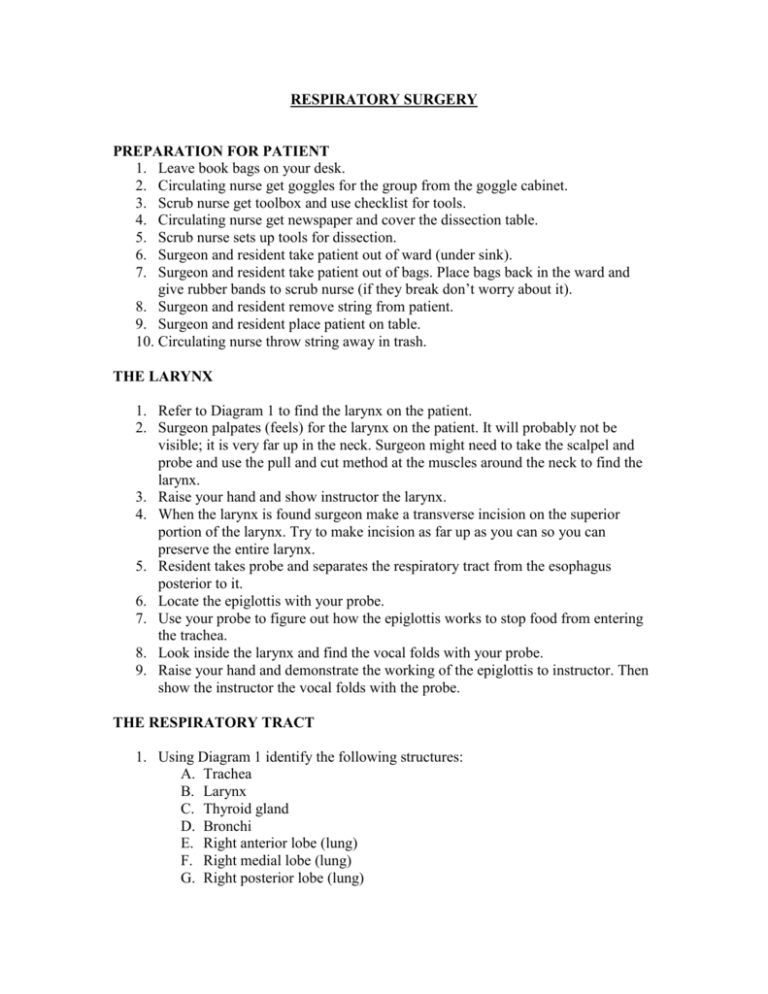
RESPIRATORY SURGERY PREPARATION FOR PATIENT 1. Leave book bags on your desk. 2. Circulating nurse get goggles for the group from the goggle cabinet. 3. Scrub nurse get toolbox and use checklist for tools. 4. Circulating nurse get newspaper and cover the dissection table. 5. Scrub nurse sets up tools for dissection. 6. Surgeon and resident take patient out of ward (under sink). 7. Surgeon and resident take patient out of bags. Place bags back in the ward and give rubber bands to scrub nurse (if they break don’t worry about it). 8. Surgeon and resident remove string from patient. 9. Surgeon and resident place patient on table. 10. Circulating nurse throw string away in trash. THE LARYNX 1. Refer to Diagram 1 to find the larynx on the patient. 2. Surgeon palpates (feels) for the larynx on the patient. It will probably not be visible; it is very far up in the neck. Surgeon might need to take the scalpel and probe and use the pull and cut method at the muscles around the neck to find the larynx. 3. Raise your hand and show instructor the larynx. 4. When the larynx is found surgeon make a transverse incision on the superior portion of the larynx. Try to make incision as far up as you can so you can preserve the entire larynx. 5. Resident takes probe and separates the respiratory tract from the esophagus posterior to it. 6. Locate the epiglottis with your probe. 7. Use your probe to figure out how the epiglottis works to stop food from entering the trachea. 8. Look inside the larynx and find the vocal folds with your probe. 9. Raise your hand and demonstrate the working of the epiglottis to instructor. Then show the instructor the vocal folds with the probe. THE RESPIRATORY TRACT 1. Using Diagram 1 identify the following structures: A. Trachea B. Larynx C. Thyroid gland D. Bronchi E. Right anterior lobe (lung) F. Right medial lobe (lung) G. Right posterior lobe (lung) H. Left anterior lobe (lung) I. Left medial lobe (lung) J. Left posterior lobe (lung) K. Mediastinal lobe (lung) L. Diaphragm M. Intercostal muscles 2. Raise your hand and identify these structures to instructor. OBSERVING THE LUNGS 1. Surgeon makes an incision on the primary bronchi or near it. 2. Insert straw into the incision you made. 3. Resident needs to blow into the straw while the others watch what the lungs do. DO NOT INSPIRE!!! 4. If your lungs do not inflate this indicates that you made some accidental incisions around the lungs. Find the holes, cover them and see if it works. 5. Raise your hand and demonstrate the inflation of the lungs to the instructor. LUNG BIOPSY 1. Using the scalpel surgeon cuts out the right anterior lobe. 2. Place the lobe in a dampened paper towel and place in a labeled cup. 3. Circulating nurse send the cup to pathology. CLOSURE OF PATIENT SURGEON AND RESIDENT 1. Get spray bottle with pink fluid inside titled Humectant. 2. Spray Humectant all over the patient. Make sure to get it inside and outside of patient, everywhere! This stuff is what we use to prevent molding. 3. Take rib cage sides and push back together. 4. Ask scrub nurse for string. 5. Use string and tie around the rib cage so the patient’s thoracic cavity is closed. 6. Take the two bags out from underneath the sink. 7. Take the two bags out from underneath the sink. 8. Place the patient, head first, into the bag that it came in. 9. Ask scrub nurse for rubber bands. 10. Rubber band the end of that bag. 11. Take the patient and place feet first into second bag (rubber banded end in first). 12. Rubber band the second bag. 13. Place patient in recovery ward (underneath your sink). Diagram 1

